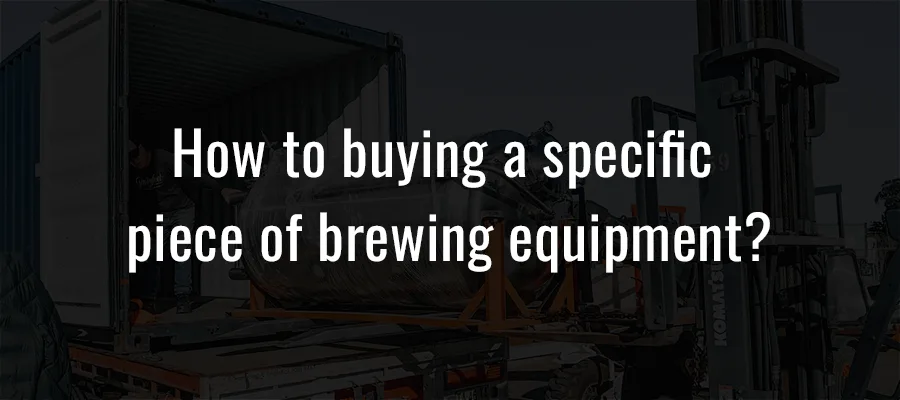If you’re considering starting a beer brewing business, selecting the appropriate brewery equipment is crucial. The worst scenario is ending up with brewing equipment that is inefficient and complicates the brewing process unnecessarily. In this article, we will explore some of the most in-demand brewing equipment available and how it can enhance your beer-making journey.
Step 1: Choose the Best Brewery Equipment Supplier in Advance
Investing in high-quality brewing equipment is crucial to ensure that your beer tastes better. Before purchasing brewery equipment, it’s important to research and find the best value for your money. It’s essential to choose equipment that not only enhances the quality of your beer but also improves its taste.
Brewery systems come in various shapes and sizes, and the designing and building process can take different amounts of time. Therefore, incorporating the purchase of beer equipment into the production planning form at least six months before opening the brewery is necessary.
When selecting a brewing equipment supplier, it’s essential to find one who can make brewing systems according to your specific needs and requirements. Quality and user experience are also vital factors to consider since you will be using the equipment for years to come.
Choosing the most suitable brewing equipment manufacturer can be a tedious process due to the variety of styles, configurations, and brewing techniques. Hence, it’s advisable to compare several brewery equipment suppliers before making a decision. Remember, buying the equipment is just the beginning, and labor-intensive manufacturing techniques require proficient knowledge and expertise from the manufacturer.
Step 2: Choose the Right Size Brewing Equipment
One of the first questions you’ll encounter when speaking with a brewing equipment supplier for the first time is which brewing system to choose. In this article, we’ll list the differences and setup costs for three types of breweries to help you make an informed decision.
To select the right brewing system, it’s essential to have a clear understanding of your brewery size and production goals. While established businesses may be aware of these factors, new businesses often overlook their importance when purchasing the brewing system that will meet their current and future needs.
Calculating a brewery’s annual production involves using the following formula: (brewhouse size) x (number of brews per week) x (50 weeks per year) = annual production. Understanding your production needs will help determine the appropriate brewing equipment size for your business.
For instance, a small Nano brewery system may suffice if you plan to produce a limited amount of beer.
In a small Nano brewery system
- A 5 BBL system x 2 brews a week x 50 weeks = 500 BBLannually
- A 5 BBLsystem x 3 brews a week x 50 weeks = 750 BBL annually
In a Medium Micro brewery system
- A 10 BBL system x 3brews a week x 50 weeks = 1500 BBL annually
- A 10 BBLsystem x 6 brews a week x 50 weeks = 3000 BBL annually
In a large commercial brewery system
- A 30 BBL system x 10brews a week x 50 weeks = 15000 BBL annually
- A 30 BBLsystem x 15 brews a week x 50 weeks = 22500 BBL annually
Once you’ve determined your target production volume, you can assess the brewery’s design maximum production efficiency based on that volume.
For instance, Nano breweries or brewpub systems typically have a capacity between 2-5 BBL and produce 200-750 barrels per year. Craft brewery systems, on the other hand, usually range from 10-15 BBL and produce 1,500-4,500 barrels per year. For a commercial brewing scale, a complete production brewing system should be 20 BBL or larger and have a capacity to produce over 10,000 barrels per year.
It’s crucial to keep in mind that different brewing systems represent various stages of a brewery’s development. Therefore, when designing a brewing system, it’s essential to ensure that the purchased system meets the brewery’s development needs for at least the next 5-10 years. A reputable supplier should provide you with various suggestions and configurations that fit within your budget.
BREWERY SOLUTION
The Premier Marketplace for Brewery Equipment
Step 3. Investing in Your Brewery for Maximum ROI
Every investment is personal, and the same holds true for the beer brewing industry. Therefore, it’s essential to select the appropriate equipment supplier and the right brewing equipment. The cost of brewing equipment is a significant factor in our ROI calculation. So, how much should we invest in brewing equipment?
Several factors influence the price of brewing equipment, such as:
- Choosing multiple equipment suppliers for comparison (see Step 1)
- Selecting the equipment size based on production goals (see Step 2)
- Availability of sufficient technical support from the manufacturer
- Quality of materials utilized in the manufacturing process
- Purchase price of the equipment within budget
- Delivery and installation of the whole system
- After-sales support
Does this seem complicated? Any successful investment necessitates complex communication and calculations. We consider all of the above aspects to ensure you get a high ROI. Contact us here to obtain all the information you require.
Take your time to compare these costs against your planned business objectives. Micet Group’s brewing equipment can assist you in making the right choice. The least expensive equipment is not always the best investment. We need to consider the supplier’s design capability, service level, material quality, manufacturing process, delivery, technical after-sales support, total lifespan, overall capacity, and how much profit this capacity will generate when everything works at maximum productivity. These factors should provide you with a better understanding of what you can afford.




